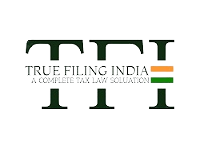Income tax return filing for a taxpayer with taxable income of less than Rs.10 lakhs.
Invoicing, GST Filing, Banking and Payroll |
GST Invoice Get GST eInvoice with Input Tax Credit |
R 3 Form is applicable for the individuals and Hindu Undivided Families that earn profit and gains from business or profession.
If the individual or the Hindu undivided family is having an income as a partner of a partnership firm that is carrying out business then ITR-3 cannot be filed as in such cases the individual is required to file ITR-2.
Eligibility for filing ITR 3 Form
Who can file ITR 3?
ITR 3 For is to be filed by the individuals and the HUFs who earn income from carrying a profession or from a proprietary business. ITR 3 Form can be used when the income of the assessee falls in the categories that are mentioned below:
- Income from carrying a profession
- Income from proprietary business
- Apart from this, the returns of the business can also include the house property, the salary or pension, and the income from other sources.
Who is not eligible to file ITR 3 Form?
In case if the individual or the Hindu Undivided Family is functioning as a partner of the partnership firm that is carrying out business or profession then he cannot file form ITR 3 as he will be eligible to file Form ITR 2.
Structure of Form ITR 3
ITR-3 is divided into:
Part A includes-
- Part A-GEN:General information and Nature of Business
- Part A-BS:Balance Sheet as of March 31, 2020, of the Proprietary Business or Profession
- Part A- Manufacturing Account:Manufacturing Account for the financial year 2019-20
- Part A- Trading Account:Trading Account for the financial year 2019-20
- Part A-P&L:Profit and Loss for the Financial Year 2019-20
- Part A-OI:Other Information (optional in a case not liable for audit under Section 44AB)
- Part A-QD:Quantitative Details (optional in a case not liable for audit under Section 44AB)
Schedules include:
- Schedule-S:Computation of income under the head Salaries.
- Schedule-HP:Computation of income under the head Income from House Property
- Schedule BP:Computation of income from business or profession
- Schedule-DPM:Computation of depreciation on plant and machinery under the Income-tax Act
- Schedule DOA:Computation of depreciation on other assets under the Income-tax Act
- Schedule DEP:Summary of depreciation on all the assets under the Income-tax Act
- Schedule DCG:Computation of deemed capital gains on the sale of depreciable assets
- Schedule ESR:Deduction under section 35 (expenditure on scientific research)
- Schedule-CG:Computation of income under the head Capital gains.
- Schedule 112A:Details of Capital Gains where section 112A is applicable
- Schedule 115AD(1)(iii)Provision:For Non-Residents Details of Capital Gains where section 112A is applicable
- Schedule-OS:Computation of income under the head Income from other sources.
- Schedule-CYLA-BFLA:Statement of income after set off of current year’s losses and Statement of income after set off of unabsorbed loss brought forward from earlier years.
- Schedule-CYLA:Statement of income after set off of current year’s losses
- Schedule BFLA:Statement of income after set off of unabsorbed loss brought forward from earlier years.
- Schedule CFL:Statement of losses to be carried forward to future years.
- Schedule- UD:Statement of unabsorbed depreciation.
- Schedule ICDS:Effect of Income Computation Disclosure Standards on Profit
- Schedule- 10AA:Computation of deduction under section 10AA.
- Schedule 80G:Statement of donations entitled for deduction under section 80G.
- Schedule RA:Statement of donations to research associations etc. entitled for deduction under section 35(1)(ii) or 35(1)(iiA) or 35(1)(iii) or 35(2AA)
- Schedule- 80IA:Computation of deduction under section 80IA.
- Schedule- 80IB:Computation of deduction under section 80IB.
- Schedule- 80IC/ 80-IE:Computation of deduction under section 80IC/ 80-IE.
- Schedule VIA:Statement of deductions (from total income) under Chapter VIA.
- Schedule SPI-SI-IF:Income of specified persons(spouse, minor, etc) includable in the income of the assessee, Income chargeable at special rates, info partnership firms in which assessee is a partner.
- Schedule AMT:Computation of Alternate Minimum Tax Payable under Section 115JC
- Schedule AMTC:Computation of tax credit under section 115JD
- Schedule SPI:Statement of income arising to spouse/ minor child/ son’s wife or any other person or association of persons to be included in the income of the assessee in Schedules-HP, BP, CG, and OS.
- Schedule SI:Statement of income which is chargeable to tax at special rates
- Schedule-IF:Information regarding partnership firms in which the assessee is a partner.
- Schedule EI:Statement of Income not included in total income (exempt incomes)
- Schedule PTI:Pass-through income details from a business trust or investment fund as per section 115UA, 115UB
- Schedule TPSA:Secondary adjustment to transfer price as per section 92CE(2A)
- Schedule FSI:Details of income from outside India and tax relief
- Schedule TR:Statement of tax relief claimed under section 90 or section 90A or section 91.
- Schedule FA:Statement of Foreign Assets and income from any source outside India.
- Schedule 5A:Information regarding apportionment of income between spouses governed by Portuguese Civil Code
- Schedule AL:Asset and Liability at the end of the year(applicable where the total income exceeds Rs 50 lakhs)
- Schedule DI:Schedule of tax-saving investments or deposits or payments to claim deduction or exemption in the extended period from 1 April 2020 until 30 June 2020
- Schedule GST:Information regarding turnover/ gross receipt reported for GST
- Part B-TI:Computation of Total Income.
- Part B-TTI:Computation of tax liability on total income.
- Verification
Instructions to be followed while filing ITR 3 Form
The Sections mentioned above will have to be addressed in the Form. But here is the list of important instructions that are to be followed while filing the ITR 3 Form:
- If in case the Schedule is not applicable to the assessee, then the assessee has to just put -NA-
- In case if there is no figure to denote, mention Nil.
- If there is a negative balance and you are writing it against a profit column then the” – ” sign needs to be added before the figure.
- Round off the figures to the nearest one rupee.
- The total income or the payable loss should be rounded off to the nearest multiple of Rs.10.
- The Section in Part A needs to be filled after that 23 schedules are to be filled in Part B, Finally, you need to verify the document.
How to file ITR 3 Form?
ITR 3 Form can be filed either offline or online:
- Offline: The returns can be furnished in a paper format through a bar-coded return.
- Online: The returns can be furnished electronically using the Digital Signature Certificate. This data can be transmitted after submitting the verification of the return.
The assessee must have two print copies of the ITR 3 Form when he is filing the returns online.
Electronic returns can be filed when:
The assessee is a resident of India or if the signing authority is located outside India.
The assessees with more than Rs.5 lakh total income are required to furnish the returns electronically.
Assessees that are claiming relief under Section 90, 90A,91 for whom the schedule FSI and Schedule TR that applies must file the returns electronically.
CALL A FREE CA CS AND CORPORATE LAWYER 24*7



